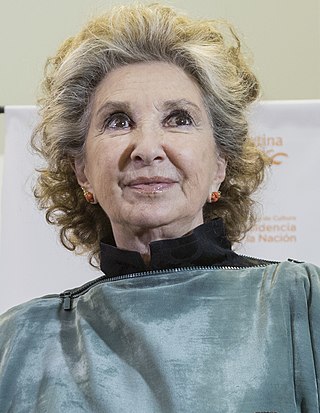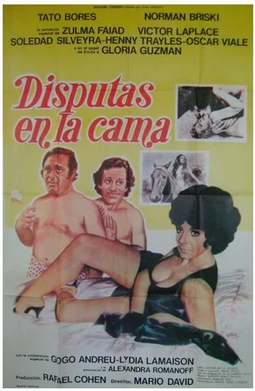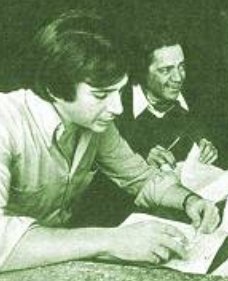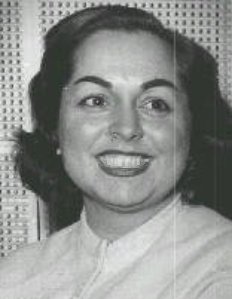
Norma Aleandro is an Argentine actress. She is considered one of the most celebrated and prolific Argentine actresses of all time and is recognized as a cultural icon in her home country.
Cumbia villera is a subgenre of cumbia music originating in Argentina in the late 1990s and popularized all over Latin America and Latin communities abroad.

Libertad Lamarque Bouza was an Argentine actress and singer, one of the icons of the Golden Age of Argentine and Mexican cinema. She achieved fame throughout Latin America, and became known as "La Novia de América". By the time she died in 2000, she had appeared in 65 films and six telenovelas, had recorded over 800 songs and had made innumerable theatrical appearances.

Olga Zubarry was an Argentine actress who appeared in film between 1943 and 1997. She made over 60 appearances in film, spanning six decades of Argentine cinema, but is best known for her work during the Golden Age of Argentine Cinema. Throughout the course of her career, she received four Silver Condor Awards, two Martín Fierro Awards, a Konex Foundation Award and several others for her films and television performances. She is credited with starring in the first film in Argentina which featured nudity, though only her back was shown and she stated repeatedly that she wore a flesh-colored mesh and was not truly nude.

The Soul of the Accordion is a 1935 Argentine tango musical film directed by Mario Soffici and written by José A. Bugliot. It is considered one of the earliest classics of Argentine cinema.

Laura Ana "Tita" Merello was an Argentine film actress, tango dancer and singer of the Golden Age of Argentine Cinema (1940–1960). In her six decades in Argentine entertainment, at the time of her death, she had filmed over thirty movies, premiered twenty plays, had nine television appearances, completed three radio series and had had countless appearances in print media. She was one of the singers who emerged in the 1920s along with Azucena Maizani, Libertad Lamarque, Ada Falcón, and Rosita Quiroga, who created the female voices of tango. She was primarily remembered for the songs "Se dice de mí" and "La milonga y yo".

Disputas en la cama, also known as Los divorciados, is a 1972 Argentine sex comedy film directed by Mario David. It stars Tato Bores, Norman Briski, Zulma Faiad, Víctor Laplace and Soledad Silveyra. A preview function with 250 guests for the film was suspended by the Qualification Body, which objected to scenes with Soledad Silveyra and Alejandra Romanof. Upon release on 11 May 1972, the film was largely panned by critics but was a box office success.

Sergio Renán was an Argentine actor, film director, and screenwriter.

Nélida Dodó López Valverde known professionally as Nelly Beltrán was an Argentine actress. She appeared on the radio from the age of 10 and in 85 theatrical performances, 48 films and 3 dozen television shows between 1953 and 1996. She won a Martín Fierro Award as Best Comic Actress for her television work on La hermana San Sulpicio; participated in the film Pajarito Gómez which won the Best Youth Film award at the 15th Berlin International Film Festival; won a Konex Foundation Award; and was honored by the Argentina Actors Association in 2004 for her career contributions.
María Eugenia Rita, better known by her stage name María Eugenia Ritó, is an Argentine dancer and vedette.

Sara Facio was an Argentine photojournalist and publisher. She was best known for having photographed, along with Alicia D'Amico, various cultural personalities, including Argentine writers Julio Cortázar, María Elena Walsh and Alejandra Pizarnik. She co-founded the publishing house "La Azotea" alongside María Cristina Orive in 1973.

Mónica Villa is an Argentine actress of stage, screen, and TV, as well as a researcher and educator. She earned a Best Actress award for her role as "Susana" in cult classic "Esperando la Carroza at the 1985 Festival de Cine Iberoamericano, in Huelva, Spain. She won an ACE Golden award for best leading actress in the 2002 comedy "Ojos traidores", a 2004 Premios Trinidad Guevara for best Actress of a Repertoire Company, a Premios Carlos de Oro for her 2011 performance as best lead actress in the theater production "Jardín De Otoño", and in 2015 a Premios Estrella de Mar for Best Female Performance in a Repertoire Company for "La Nona". In addition, she has been nominated for a Best Actress in a TV Special for the 2003 Premios Martín Fierro, making her acting work recognized in all three major media.

María Miterloi Hernández, better known by her stage name Maruja Montes, was a Brazilian-born Argentine actress and vedette who performed during the middle part of the 20th century.

Paulina Singerman Begun was an Argentine actress and businesswoman who primarily worked during the Golden Age of Argentine Cinema, performing on both stage and in films. In the later part of her career, she spent a decade performing for television. She was the younger sister of actress Berta Singerman. In 1981, she was awarded both a Diploma of Merit and a Platinum Konex for her comedy work in film and theatre.

Estudios San Miguel was an Argentine film studio that was active in the 1940s and early 1950s. It flourished during the golden age of Cinema of Argentina, and at its peak was one of the major studios in Buenos Aires. Genres ranged from musical comedy to costume drama and gaucho thriller. Films included La guerra gaucha, co-produced with Artistas Argentinos Asociados, and the comedy Juvenilia (1943), both of which won several major awards. Eva Duarte, soon to become the first lady of Argentina as Eva Perón, appeared in two of the studio's films in 1945. The studio became overextended financially and ceased production after 1952.
Víctor Hugo Caula was an Argentinian cameraman and director of photography, with extensive participation in the production of works.

María Seoane was an Argentine economist, journalist, and writer who ventured into film. She won numerous awards and published eight books on political issues in Argentine history. She was the director of LRA Radio Nacional from 2009 until her resignation on 21 December 2015. Seoane died on 27 December 2023, at the age of 75.
Rey Muerto is a 12-minute fictional live-action short film written and directed by Argentine filmmaker Lucrecia Martel and released 19 May 1995. It was included in Historias breves I, the first edition of the INCAA competition, which was fundamental to the rise and recognition of the generation of Argentine filmmakers known variously as Cine Independiente Argentino or Nuevo Cine Argentino.
Silvia Rivas is an Argentine visual artist known for her multi-channel video installations. In Latin America she is considered a precursor in the area of expanded video. Her work is characterized by the crossing of materialities and technologies in which she uses both electronic devices and ancestral techniques. Her production is organized in thematic series of video installations, drawings, photographs or objects. Interested in revealing the metaphorical power of different materialities, she uses the electronic medium and the moving image to record stillness, the imminent and the subjective perception of time.
Alfredo Ruanova, was an Argentine writer, screenwriter and film producer.












